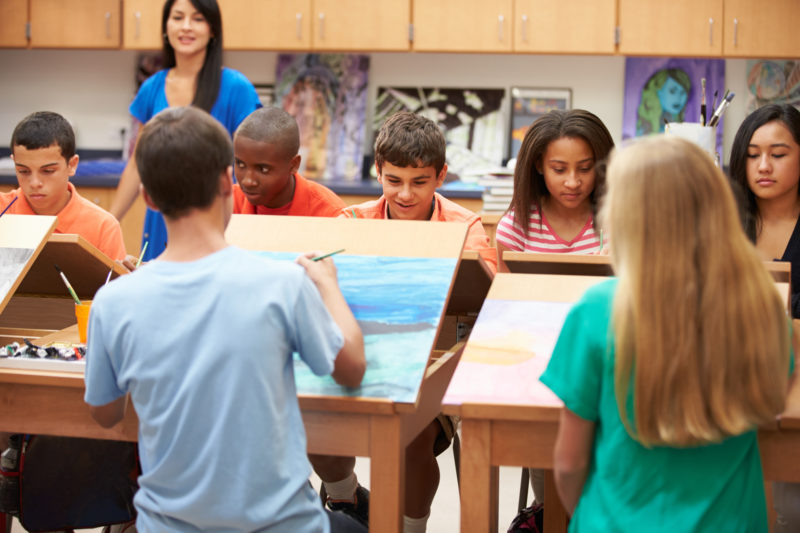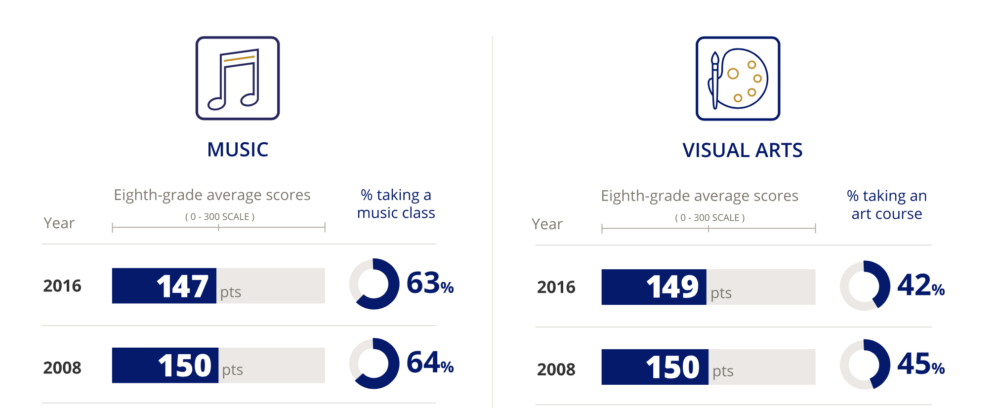 The National Assessment Governing Board (NAGB) recently released the first national assessment of students' performance in visual arts and music in eight years. More commonly known as the "Nation’s Report Card," the National Assessment of Educational Progress (NAEP) measured eighth grade students’ abilities to create, perform, and respond to art, as well as their general knowledge of the arts.
The National Assessment Governing Board (NAGB) recently released the first national assessment of students' performance in visual arts and music in eight years. More commonly known as the "Nation’s Report Card," the National Assessment of Educational Progress (NAEP) measured eighth grade students’ abilities to create, perform, and respond to art, as well as their general knowledge of the arts.
Overall, scores remained relatively flat compared with 2008, although differences emerged among racial groups, family income levels and geographic areas. In addition, the report card found that over the past eight years, access to arts did not drop significantly despite fears over the impact of school budget cuts. In 2106, 63% of eighth-graders took a music class and 42% took an art class. Still too low, but not statistically different from 2008 when 43% took art and 65% took music.
"The visual arts and music have always been vital components to students' well-rounded education, which is why they are included in NAEP," said Dr. Joe Willhoft, a testing and measurement expert and a member of the NAGB board. "And as a former art teacher, I've seen firsthand how the arts — music, visual arts, drama and dance — are an essential part of a student's learning and development."
Achievement Gaps Narrows
When it came to responding to music (which includes analyzing, critiquing, identifying, describing and explaining music), eighth graders did not make any significant progress or digress compared to 2008.
The average music responding scale score for eighth-grade students in 2016 was 147, and the average score in 2008 was 150, both on a 0-300 score scale.
Music scores for lower-, middle-, and higher-performing eighth graders compared to 2008 also showed no significant shift.
There was, however, a significant change in Hispanic students average score. Hispanic eighth graders in 2008 had scored an average of 129, but last year, in 2016, the average score was 135.
Not only have scores among Hispanic students improved, but the gap between White eighth-grade students and Hispanic eighth-grade students narrowed significantly compared to 2008. White eighth-grade students scored 23 points higher than the average score for their Hispanic peers - smaller than 32-point difference in 2008.
 Source: National Assessment of Educational Progress: Arts 2016
Source: National Assessment of Educational Progress: Arts 2016
The average visual arts responding scale score for eighth-graders was not significantly different compared to 2008. The average score for eighth-grade students in 2016 was 149, and the average score for eighth-grade students in 2008 was 150.
Unlike high-performing eighth graders in music, the highest-performing eighth graders scored lower in visual arts in 2016 compared to 2008. The results for lower- and middle-performing students did not change significantly, but the highest-performing students scored 189 points in visual arts, compared to 193 points in 2008.
The gap between the Hispanic and White eighth-grade students also narrowed significantly compared to 2008. In 2016, the average responding score in visual arts for White eighth-grade students was 19 points higher than the average score for their Hispanic peers - smaller than the 26-point gap in 2008.
Asian/Pacific Islander students scored 8 points higher on average than White students in 2016 while there was no significant difference between these two student groups in 2008.
In both music and visual arts:
- Female students scored higher on average than their male peers.
- Students not eligible for the National School Lunch Program (NSLP) scored higher on average than eligible students.
- Students in suburban schools scored higher on average than those in city schools.








